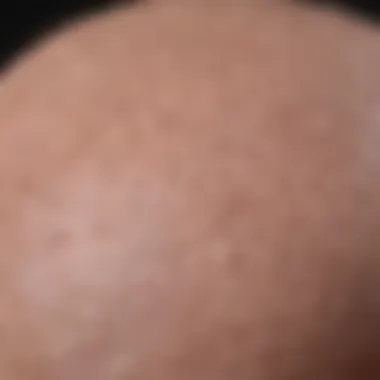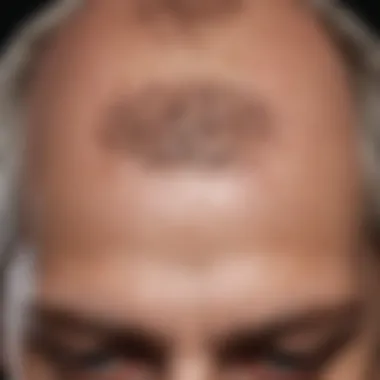Understanding White Crusty Patches on the Scalp


Summary of Objectives
This article explores the condition characterized by white crusty patches on the scalp. It aims to provide an in-depth examination of potential causes, symptoms, methods of diagnosis, treatment options available, and preventive measures. The analysis will also extend to related skin conditions that may share similar characteristics, enhancing the discourse around scalp health.
Importance of the Research
Understanding the etiology of white crusty patches is vital for effective interventions. This topic not only holds significance in dermatology but also impacts related health sciences. By disseminating accurate and thorough information to students, researchers, educators, and professionals, this article endeavors to foster informed perspectives and innovative research-based practices in scalp health and dermatology.
Prologue
The presence of white crusty patches on the scalp can signal various underlying health issues. Recognizing the symptoms and causes is crucial for timely diagnosis and treatment. Patients often disregard such symptoms, leading to worsening conditions. This article provides a structured. detailed overview of this common yet often misunderstood issue.
Causes
Understanding the primary causes of white crusty patches helps in assessing possible treatment routes. Common causes include:
- Seborrheic Dermatitis: Often appears as flaky, yellowish patches. This condition is linked to an overproduction of oil and fungal growth.
- Psoriasis: Characterized by red patches covered with silvery scales. This is an autoimmune disorder that prompts rapid skin cell growth.
- Eczema: A result of inflammation affecting the scalp, leading to dry and flaky skin. It can be triggered by environmental factors or allergens.
- Fungal Infections: Conditions such as tinea capitis can lead to crusty patches, often accompanied by hair loss.
Symptoms
Individuals with white crusty patches may notice various symptoms, including:
- Itching or irritation.
- Redness or inflammation around the patches.
- Scaly appearance that can be white or yellow.
- Possible hair loss in severe cases.
Recognizing these symptoms early can lead to better management strategies.
Diagnosis
Diagnosis typically involves a comprehensive physical examination by a healthcare provider. In some cases, a skin biopsy may be necessary to determine the exact cause. Patients might also undergo:
- Wood's Lamp Examination: Helps identify fungal infections.
- Laboratory Tests: To assess for underlying autoimmune disorders or infections.
Treatment Options
Depending on the diagnosed condition, several treatment pathways exist. These may include:
- Topical Treatments: Such as corticosteroids for inflammation reduction.
- Antifungal Medications: For infections caused by fungi.
- Moisturizers: To alleviate dryness in cases of eczema or psoriasis.
- Phototherapy: Can be effective in severe psoriasis.
Careful follow-up is essential to monitor progress and adapt treatments as necessary.
Prevention Strategies
Preventing white crusty patches often entails simple lifestyle adjustments:
- Maintain proper scalp hygiene.
- Use moisturizing shampoos and conditioners.
- Minimize stress levels, as stress can exacerbate skin conditions.
Regular consultations with dermatologists can also facilitate early detection and management of scalp issues.
Key Point: It is crucial for individuals to seek medical advice on white crusty patches. Proper evaluation and treatment can prevent long-term complications and improve overall scalp health.
Related Skin Conditions
Awareness of related skin conditions enhances understanding. Conditions like tinea capitis and contact dermatitis may share overlapping symptoms but require distinct treatment approaches. Staying informed about these can aid in early detection of more severe health issues.
By articulating the complexities of white crusty patches on the scalp, healthcare professionals can better serve patients, providing insightful guidance towards healthier skin and scalp.
Preface to Scalp Conditions
Understanding scalp conditions is crucial for maintaining overall skin health. The scalp is a specialized area of skin that can face various challenges, such as irritation, inflammation, or infection. It serves as a protective barrier and supports healthy hair growth. Therefore, recognizing and addressing abnormalities, like white crusty patches, can prevent potential complications and improve quality of life.
Overview of Scalp Health
Scalp health is often an overlooked aspect of personal care. Numerous factors contribute to maintaining a healthy scalp, including hygiene, environmental exposure, and individual skin types. A healthy scalp provides a foundation for robust hair follicles and contributes to optimal hair growth. On the contrary, an unhealthy scalp can lead to dandruff, hair thinning, or more severe dermatological issues.
The natural balance of oils and microorganisms needs to be preserved for an optimal environment. Abrupt changes, such as excessive washing or use of harsh chemicals, can disrupt this balance.


- Recognizing Key Symptoms: Awareness of scalp symptoms like itching, redness, or unusual growths can signal underlying issues that require attention.
- Building Good Practices: Educating oneself about best practices in scalp care can preclude many potential problems.
Importance of Identifying Scalp Anomalies
Identifying scalp anomalies is important not just for cosmetic reasons but also for health considerations. Any unusual change in the scalp’s appearance can indicate conditions as simple as dry skin to more complex issues, like psoriasis or fungal infections. Timely recognition allows for early intervention and tailored treatment.
- Preventing Complications: Ignoring symptoms can lead to significant complications. For example, untreated seborrheic dermatitis may progress, increasing the risk of secondary infections.
- Guiding Treatment Options: Distinct conditions require specific treatment approaches. Identifying anomalies leads to effective management strategies, be it through over-the-counter remedies or medical interventions.
- Enhancing Quality of Life: Managing scalp conditions adequately can enhance self-esteem and overall well-being. This, in turn, affects happiness and social interactions.
Recognizing and understanding different scalp conditions lays the groundwork for addressing issues like white crusty patches. This proactive approach serves to not just treat but also educate individuals, promoting healthier scalp and hair practices going forward.
Characteristics of White Crusty Patches
Understanding the characteristics of white crusty patches is essential for anyone experiencing this scalp condition. Recognizing these features is crucial as it can help in identifying the underlying causes and directing appropriate treatment methods. The physical attributes and associated symptoms provide valuable insights into potential skin conditions that could be affecting scalp health. Additionally, being able to describe these characteristics can play a key role in effective communication with healthcare professionals.
Physical Appearance
The physical appearance of white crusty patches on the scalp can vary significantly. Typically, these patches are described as flaky and dry. They may appear isolated or, in some cases, can cluster in specific areas of the scalp. The color is usually white, but they can also have a yellowish tinge. The texture of the patches can be fine, resembling dandruff, or thicker and more scaly. In severe cases, the crust might crack, leading to bleeding.
Key points about physical appearance include:
- Flakiness: This is a primary visual cue.
- Color Variations: While often white, some may display a yellow hue.
- Thickness: Ranges from fine flakes to thick crust.
- Location: Patches may be localized or widespread across the scalp.
Importantly, some individuals may experience hair loss in areas affected by these patches, which can further complicate the diagnosis. Identifying these traits can facilitate better understanding and prompt treatment.
Understanding the visual characteristics of scalp conditions is critical for timely intervention and management.
Common Symptoms
Common symptoms accompanying white crusty patches extend beyond mere appearance. These symptoms can vary among individuals but generally include irritation and itching. Some may find the affected areas painful or sensitive to touch. Rubbing or scratching can exacerbate these feelings, often leading to inflammation.
Other symptoms to consider are:
- Redness: Surrounding inflammation may present as reddish skin around the patches.
- Discomfort: Itching or irritation can affect daily life and comfort levels.
- Flaking: Excessive shedding of skin cells is commonplace and can fall onto clothing or furniture.
- Hair Loss: In localized areas, hair may thin or fall out due to the condition.
Being aware of these symptoms plays a vital role in understanding the full impact of the condition. It allows for better self-management strategies and aids in seeking appropriate medical intervention when needed.
Potential Causes
Understanding the potential causes of white crusty patches on the scalp is crucial for both diagnosis and treatment. These conditions can stem from a variety of underlying reasons, and recognizing them is key in developing effective management strategies. Each cause has distinctive features that can guide clinical management. Careful consideration of these factors leads to better patient outcomes and enhances overall scalp health. In this section, we will delve into the primary causes including seborrheic dermatitis, psoriasis, fungal infections, contact dermatitis, and other skin conditions.
Seborrheic Dermatitis
Seborrheic dermatitis is a chronic skin condition that often affects oily areas of the body, notably the scalp. It manifests as red, greasy patches with white or yellow crusty scales. This condition is associated with increased sebum production and a proliferation of the Malassezia yeast, which is naturally found on the skin.
Symptoms can vary in intensity and might include itchiness and discomfort. Factors such as stress, climate changes, and genetics can exacerbate seborrheic dermatitis. Treatment often involves the use of medicated shampoos containing ingredients like ketoconazole or salicylic acid. Emphasizing scalp hygiene and regular washing can also aid in the management of this condition.
Psoriasis
Psoriasis is an autoimmune disorder leading to rapid skin cell turnover. On the scalp, this results in thick, silvery-red patches with crusty scales. This condition can extend beyond the scalp, affecting other areas such as elbows and knees.
Typical symptoms include itching, burning sensations, and even hair loss in some cases. Psoriasis is linked to various triggers including stress, infections, and certain medications. Effective management often requires a multidisciplinary approach that can include topical treatments such as corticosteroids, phototherapy, and systemic medications for more severe cases.
Fungal Infections
Fungal infections of the scalp, known as tinea capitis, can cause white crusty patches. This is particularly common in children, although it can occur at any age. The infection is typically caused by dermatophyte fungi, which thrive in warm and moist environments.
Symptoms may include itching, hair loss, and the formation of scaly patches. It is important to diagnose fungal infections promptly since they can be contagious. Treatment usually involves antifungal medications, either topical or oral, depending on the severity of the infection.
Contact Dermatitis
Contact dermatitis results from an allergic reaction or irritation to substances that come into contact with the scalp. It can manifest as red, itchy patches, including crusty areas. Common triggers include hair care products, such as dyes, shampoos, or styling products.
Identifying the source of irritation is crucial. Avoiding the offending products and switching to hypoallergenic alternatives can be effective. In some cases, topical corticosteroids may be required to reduce inflammation and alleviate symptoms.
Other Skin Conditions


Beyond the more common causes, various other skin conditions can lead to white crusty patches on the scalp. Conditions like folliculitis, where hair follicles become inflamed, or eczema might also be involved. Each has its own set of symptoms and treatment protocols.
For instance, folliculitis may cause red, pus-filled bumps, while eczema can lead to dryness and scaling. Understanding these different conditions is vital for accurate diagnosis and treatment. It is essential for individuals experiencing scalp symptoms to seek professional evaluation for proper identification and management.
Diagnosis Protocols
Accurate diagnosis of white crusty patches on the scalp is crucial for effective treatment and management of any underlying conditions. The Diagnosis Protocols section outlines a comprehensive approach to identifying the root cause of these patches. Proper diagnosis not only helps in recognizing the specific condition but also aids in preventing potential complications that can arise from misdiagnosis. The need for precise diagnosis is amplified when considering that several conditions can manifest similarly on the scalp.
Clinical Examination
A clinical examination is often the first step in diagnosing scalp conditions. During this process, a healthcare professional will visually assess the affected area. Important factors to consider include:
- The size and distribution of the patches.
- The texture and color of the skin and scales.
- Any accompanying symptoms such as itching or inflammation.
By asking targeted questions about the patient's medical history and conducting a thorough physical examination, the clinician can gather vital clues. A detailed history might reveal whether the patient has a history of skin conditions or allergies, which can significantly inform the diagnosis.
Laboratory Testing
In cases where the clinical examination does not yield definitive results, laboratory testing may be employed. This step is essential to determine if an underlying infection or condition is contributing to the symptoms. Common laboratory tests include:
- Skin scrapings: Used to analyze fungal infections.
- Blood tests: To assess for systemic issues or autoimmune conditions.
- Biopsies: In rare cases, a small sample of skin may be taken to study under a microscope.
These tests can help rule out or confirm specific disorders. Results from laboratory testing can be critical in guiding treatment decisions, as some conditions may require distinct therapeutic approaches.
Differential Diagnosis
Differential diagnosis refers to the systematic approach of distinguishing one condition from another. In the context of white crusty patches, it is essential to differentiate between conditions such as:
- Seborrheic dermatitis
- Psoriasis
- Fungal infections
- Contact dermatitis
The healthcare provider will weigh clinical findings and laboratory results against a list of potential diagnoses. This process aims to exclude other possible skin disorders that may present similarly, ensuring that the patient receives the most appropriate treatment.
"Correct identification of scalp disorders allows for targeted interventions, reducing unnecessary treatments and improving patient outcomes."
Treatment Options
Understanding the various treatment options for white crusty patches on the scalp is crucial for effective management of the condition. Treatments must be tailored to the individual’s specific symptoms and underlying causes. By exploring these options, one can better navigate the complexities of scalp health and make informed decisions regarding their care.
Over-the-Counter Solutions
Over-the-counter (OTC) solutions serve as a convenient first line of action for many individuals. These products are readily available and can often alleviate mild symptoms associated with white crusty patches. Common OTC solutions include medicated shampoos containing ingredients such as zinc pyrithione, selenium sulfide, or coal tar.
Benefits of using OTC treatments involve accessibility and cost-effectiveness. They often provide instant relief from itching and redness, making them appealing for early intervention. Users should always check for any potential allergens in the ingredient list, as some may cause additional irritation or allergic reactions.
Prescription Medications
In cases where over-the-counter products fail to deliver adequate relief, prescription medications may become necessary. Dermatologists often prescribe topical corticosteroids to reduce inflammation and irritation. For severe conditions, stronger systemic treatments, such as methotrexate or biologics, might be indicated.
When considering prescription options, it is essential to evaluate the benefits against potential side effects. Consultations with healthcare professionals can provide insight into the best course of treatment based on individual health needs and pre-existing conditions. Following the prescribed regimen is key to achieving the desired results.
Home Remedies
For those seeking alternative treatment avenues, home remedies can offer a complementary approach. These remedies often involve ingredients found in the kitchen or health food stores. Natural oils, such as coconut oil or tea tree oil, are frequently recommended for their soothing properties.
- Coconut Oil: This oil can help moisturize the scalp and reduce flakiness.
- Tea Tree Oil: Exhibits antifungal properties, which may be beneficial for fungal-related scalp issues.
- Aloe Vera: Known for its soothing and hydrating properties, it can help alleviate scalp irritation.
Home remedies should be approached with caution. The effectiveness of these treatments can vary, and individuals might experience different outcomes. Always test a small area first to rule out adverse reactions.
Remember: While OTC solutions, prescription medications, and home remedies all play important roles, diagnosing the underlying cause of the white crusty patches is vital for effective treatment. Engaging with a healthcare professional can provide tailored recommendations for the best results.
Preventative Measures
Preventative measures play a crucial role in managing white crusty patches on the scalp. These strategies help minimize the risk of recurrence and maintain overall scalp health. Understanding how to effectively care for the scalp can enhance quality of life and reduce the potential for more severe skin conditions. This section focuses on three key areas: scalp hygiene practices, dietary considerations, and stress management techniques.
Scalp Hygiene Practices


Maintaining proper scalp hygiene is essential for preventing white crusty patches. Regular shampooing with a gentle, medicated cleanser can help keep excess oils and skin cells at bay. This practice not only removes dirt and sebum but also can alleviate any build-up that contributes to irritation or flaking.
Key practices include:
- Washing frequency: Depending on individual scalp conditions, washing every two to three days may be optimal. Overwashing can lead to dryness, while inadequate washing can encourage the growth of irritants.
- Choosing the right products: Opt for shampoos that are free from sulfates and parabens as these can aggravate sensitive skin. Medicated shampoos containing ingredients like ketoconazole or zinc pyrithione can be beneficial.
- Rinsing thoroughly: Ensure all shampoo and conditioner are rinsed away completely to avoid residue buildup, which can also cause irritation.
Dietary Considerations
Diet has a significant impact on skin health, including the scalp. A well-balanced diet rich in essential nutrients can support the body's ability to maintain healthy skin. Omega-3 fatty acids, antioxidants, and vitamins A, C, D, and E are especially relevant to skin health.
Consider incorporating the following foods:
- Fatty fish: Salmon and mackerel are high in omega-3s, which can reduce inflammation in the skin.
- Fruits and vegetables: Berries, spinach, and carrots provide antioxidants that protect against skin damage.
- Nuts and seeds: Sources of vitamin E, like almonds and sunflower seeds, can enhance skin barrier function.
Maintaining hydration is also vital—drink plenty of water daily to help keep the skin moisturized.
Stress Management Techniques
Stress can exacerbate scalp conditions, leading to inflammation and an increase in white crusty patches. Finding effective stress management techniques is crucial for maintaining scalp health.
Effective strategies include:
- Mindfulness and meditation: Practices like meditation can reduce anxiety and promote relaxation, benefiting the overall skin condition.
- Physical activity: Regular exercise helps manage stress levels by releasing endorphins. Activities such as yoga or walking can be especially soothing.
- Adequate sleep: Sleep is essential for skin repair and overall health. Aim for 7-9 hours of sleep per night.
In summary, taking proactive steps in scalp care through hygiene, diet, and stress management can significantly reduce the likelihood of developing white crusty patches on the scalp. By implementing these preventative measures, individuals can achieve not only a healthier scalp but also improved overall well-being.
Related Conditions
Understanding related conditions is crucial in the context of white crusty patches on the scalp. Such patches can be symptomatic of broader dermatological issues. Recognizing these relationships allows for a more precise diagnosis and effective treatment plan.
Dandruff
Dandruff is a common condition that manifests as flaking skin on the scalp. It is often chronic and can coincide with symptoms of redness or itchiness. The flakes typically appear white or yellow, depending on whether they are dry or oily. Dandruff is primarily attributed to an overgrowth of Malassezia, a type of fungus that naturally exists on the scalp. Factors such as stress, dry skin, and hormonal changes can exacerbate this condition. Treating dandruff usually involves specialized shampoos containing active ingredients like zinc pyrithione or salicylic acid. These treatments help to reduce flaking and control the underlying fungal growth.
Folliculitis
Folliculitis refers to the inflammation of hair follicles, which can result in red, pus-filled bumps or crusty patches on the scalp. This condition may stem from several causes, including bacterial or fungal infections. Sometimes, physical damage, like shaving or tight hairstyles, leads to irritation of the hair follicles. Mild cases often resolve themselves, but persistent or severe folliculitis might require topical antibiotics or antifungal agents. Recognizing this condition is important, as it can sometimes mimic the appearance of white crusty patches and may coexist with other scalp issues.
Eczema
Eczema on the scalp, also known as seborrheic eczema, presents as itchy, inflamed patches that can become crusty and flaky. This condition is often linked to genetic factors and immune response issues. Stress, temperature fluctuations, and certain products may trigger flare-ups. Treatments often include moisturizers and topical corticosteroids to alleviate inflammation and manage symptoms. Since eczema can overlap with other scalp conditions, understanding its manifestations is vital for accurate diagnosis and optimal management.
Future Research Directions
Future research into white crusty patches on the scalp is essential for several reasons. First, understanding these conditions can refine existing diagnosis and treatment protocols. This is particularly significant as many skin conditions exhibit overlapping symptoms. Enhanced clarity in identification can directly influence patient outcomes.
Emerging Treatments
Innovative treatments are on the rise for scalp conditions. Research into biologics and topical therapies may offer new solutions. Current treatments often focus on symptom management without addressing underlying causes. Future studies could explore the efficacy of natural extracts or advanced formulations to provide more effective options. Adoption of personalized medicine will also allow treatments tailored to individuals based on specific pathology or genetic factors. Trials evaluating these new approaches and their impacts will be vital in shaping future care practices.
Understanding Pathophysiology
A deeper comprehension of the pathophysiology behind these scalp conditions can unveil crucial therapy targets. Research should focus on the biological mechanisms contributing to the formation of white crusty patches. Identifying specific inflammatory pathways could lead to the discovery of novel biomarkers. Furthermore, exploring the role of the microbiome in scalp health is also necessary. There is emerging evidence that fungal and bacterial populations significantly impact scalp conditions. Studies that investigate these elements could lead to breakthrough insights into prevention and management strategies.
In summary, exploring these future research directions is vital. Not only can they enhance treatment options but also improve overall understanding of scalp conditions and their complexities.
Culmination
Summary of Findings
Throughout this article, we explored various aspects of white crusty patches on the scalp. Here are the key takeaways:
- Characteristics: The patches often appear as flaky, scaly areas and can be associated with symptoms like itching or redness.
- Potential Causes: Conditions such as seborrheic dermatitis, psoriasis, and fungal infections have been identified as common triggers.
- Diagnosis and Treatment: Diagnosis typically involves clinical examination and may include laboratory testing. Treatment options range from over-the-counter solutions to prescription medications.
- Prevention: Maintaining good scalp hygiene and considering dietary factors can be effective in preventing future occurrences.
- Related Conditions: It was also noted how conditions like dandruff and eczema relate to the scalp patches.
Implications for Practice
The insights gathered from this article contribute meaningfully to practical applications in dermatology and patient care. Healthcare professionals must recognize the value of thorough evaluation when patients present with scalp anomalies. Education for patients about self-examination and recognizing early symptoms can lead to timely intervention.
Furthermore, advancements in understanding related conditions and ongoing research in emerging treatments underline the importance of this field. By integrating knowledge of scalp health into practice, clinicians can enhance treatment protocols and improve patient outcomes.
"Knowledge is power; understanding scalp conditions is essential for effective treatment."















